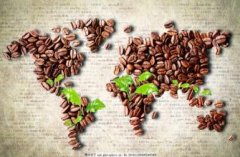A brief introduction to the flavor characteristics of Brazilian yellow bourbon coffee beans

The variants of the Bourbon family
Kenya
"SL28" and "SL24" is a bourbon line screened and cultivated by French and British missionaries and researchers in Kenya at the beginning of the 20th century. For a hundred years, it has adapted to the high concentration of phosphate soil in Kenya, and the Kenyan bean has a special sour aura, which is different from the bourbon bean in Central and South America. However, after it was transplanted to Asia, it lost its flavor and could not show their characteristics.
Yellow bourbon
"Bourbon Amarello" yellow bourbon is a unique yellow-skinned bourbon variety in the Brazilian state of Sao Paulo. Coffee fruits usually turn red when ripe, but yellow bourbon does not turn red when ripe, so it is named after orange. Huang Boban became Deep-Fried Chicken of the boutique coffee industry because he almost won the top three prizes in "CoE" (Chinese name: extraordinary Cup).
Kaddura
"Caturra" is a single gene variant of bourbon discovered in Brazil in the 1950s. It has better yield and disease resistance than bourbon, and the tree is shorter and easy to harvest. Unfortunately, it has the same problem as bourbon-- as a result, it has a year off, and the flavor is equal to or slightly worse than bourbon beans.
But it is more adaptable, can be planted with high density, does not need shade trees, and can be vibrant in direct exposure to the sun, so it is also called "exposed coffee" (Sun Coffee).
Kaddura is suitable for high altitude areas from 700m to 1700 m, but the higher the altitude is, the better the flavor is, and the bean yield is relatively reduced. There are also variants of yellow Kaddura in Central and South America, but the wind rating is not as good as Huang bourbon.
Pacas
"Pacas" in 1935, El Salvador coffee farmer "Don Alberto Pacas" selected high-production San Ramon bourbon varieties and moved them to the farm for planting. In 1956, his coffee tree produced more fruit than the same kind of coffee trees. University of Florida professor "Dr. William Cogwill" identified this as a genetic mutation in bourbon and named it "Pacas".
Pacas, with its high output and good quality, is popular in Central America. Currently, 68% of El Salvador is bourbon, while Pacas has 29%.
Coffee was first introduced to Brazil in the early 18th century. In 1727, the Brazilian government sent a personable army officer to secretly bring coffee seeds back to Brazil from French Gaiana under the pretext of mediating border disputes. It is said that the governor's wife of French Gayana was so fascinated by the officer that she secretly brought coffee tree seeds to him at a farewell dinner party. At present, 2 million hectares of land in Brazil is used to grow coffee, with the largest being Arabica. The beans will eventually be sent to the big bakers in various countries, known as Santos (in the name of the port of export, santos, not the producing area).
Brazilian boutique coffee
Brazil has also proved to be able to produce gourmet coffee and small quantities of coffee, and the local boutique coffee can not only be provided by small-scale coffee farmers. The main coffee producing areas in Brazil are Sulde Minas South Minas, Matas de Minas Minas South East Mountain Forest, Cerrado Hirado, the north-central mausoleum of Chapadas de Minas Minas, Mogiana, Paran á Parana and Bahia Bachia. There are both traditional varieties and variants, such as Bourbon, Mondo Novo Mondonovo, Icat ú Ikatu, Kaduai, Iapar, cultivated card Taiyi.
[boutique listing] Yellow bourbon sun treatment of Queen Mongiana Manor in Brazil
Brazil Rainha Yellow Bourbon Natural
Producing area: Alta Mogiana, Sao Paulo Paulo
Estate: Fazenda Rainha Manor (Queen Farm)
Variety: yellow bourbon (Yellow Bourbon)
Altitude: average 1150 ft 1350 m
Treatment: natural sun drying
Flavor features: balanced sweet, creamy smooth, orange, apricot and other fruit flavor, chocolate
Bourbon is almost all round beans, beans are a little smaller than tin card, ripening later, but the yield is 30% more than tin card. It is suitable for growing above 1200 meters above sea level, and its flavor is obviously more prominent than those below 1000 meters, but bourbon has a disadvantage that it will rest for a year as a result. Round bourbon is full of vitality, and its resistance to rust leaf disease is better than that of iron pickup, but its flavor is as good as it, or even better.
In 1810, some of the round beans in Bourbon Island mutated into pointed beans, which is known as the "pointed bourbon". It is characterized by a caffeine content of only half, low output, weak physique, and extremely rare, just like a weak aristocratic teenager.
In addition, the biggest thing that iron pickup and bourbon have in common is that they both need the protection of shade trees. if there is no shade tree to help it block the sun, it is not only not conducive to its growth, but also greatly reduces the flavor of coffee beans. "SL28" and "SL24" is a bourbon line screened and cultivated by French and British missionaries and researchers in Kenya at the beginning of the 20th century. For a hundred years, it has adapted to the high concentration of phosphate soil in Kenya, and the Kenyan bean has a special sour aura, which is different from the bourbon bean in Central and South America. However, after it was transplanted to Asia, it lost its flavor and could not show their characteristics. "Bourbon Amarello" yellow bourbon is a bourbon variant of the yellow skin unique to the Brazilian state of Sao Paulo. Generally, coffee fruit turns red when it is ripe, but yellow bourbon does not turn red when it is ripe, so it is named after orange. Because Huang Boban almost won the top three prizes in "CoE" (Cup of Excellence, Chinese name: extraordinary Cup), Deep-Fried Chicken "Caturra" became the boutique coffee industry. It was a single gene variant of bourbon discovered in Brazil in the 1950s. It had better yield and disease resistance than bourbon, and the tree was shorter and easy to harvest. Unfortunately, it encountered the same problems as bourbon-- as a result, it took a year off. The flavor is on a par with bourbon beans or slightly worse.
But it is more adaptable, can be planted with high density, does not need shade trees, and can be vibrant in direct exposure to the sun, so it is also called "exposed coffee" (Sun Coffee).
Kaddura is suitable for high altitude areas from 700m to 1700 m, but the higher the altitude is, the better the flavor is, and the bean yield is relatively reduced. There is also a variety of yellow Kaddura in Central and South America, but the wind review is not as good as Huang bourbon.
"Bourbon" bourbon is an ancient and excellent variety juxtaposed with iron pickup, and some botanists believe that bourbon is an early variety of iron pickup after it was transplanted to Yemen.
Bourbon is almost all round beans, beans are a little smaller than tin card, ripening later, but the yield is 30% more than tin card. It is suitable for growing above 1200 meters above sea level, and its flavor is obviously more prominent than those below 1000 meters, but bourbon has a disadvantage that it will rest for a year as a result. Round bourbon is full of vitality, and its resistance to rust leaf disease is better than that of iron pickup, but its flavor is as good as it, or even better.
In 1810, some of the round beans in Bourbon Island mutated into pointed beans, which is known as the "pointed bourbon". It is characterized by a caffeine content of only half, low output, weak physique, and extremely rare, just like a weak aristocratic teenager.
In addition, the biggest thing that iron pickup and bourbon have in common is that they both need the protection of shade trees. if there is no shade tree to help it block the sun, it is not only not conducive to its growth, but also greatly reduces the flavor of coffee beans.
Gene mutant
Force, caramel smell
Important Notice :
前街咖啡 FrontStreet Coffee has moved to new addredd:
FrontStreet Coffee Address: 315,Donghua East Road,GuangZhou
Tel:020 38364473
- Prev

Brief introduction of Grinding scale and Baking degree treatment method of Panamanian Flower Butterfly Coffee beans
In 1931, he obscure exported Kenya from Geisha Mountain Mountain in southwestern Ethiopia to Tanzania and Costa Rica, then transplanted to Panama in the 1960s, and then went through nearly half a century before he became a blockbuster, defeating the victorious armies such as Bourbon, Kaddura, Kaduai, Tibica and so on, winning 2005 in one breath.
- Next

A brief introduction to the origin, development, history and culture of high-quality coffee bourbon beans
In the case of the Queen's Manor, the environmental protection is quite thorough. Because of the high terrain and non-plain terrain, it is impossible to use machines to harvest, and the fruits can be harvested completely by hand. And plant low-yield and high-quality bourbon species, as the essence of high-quality Brazilian coffee on behalf of the manor! This batch of Queen's Manor (Fazenda Rainha) belongs to the Carvalho Dias family, and the estate has been for Pakistan for more than 116 years.
Related
- Detailed explanation of Jadeite planting Land in Panamanian Jadeite Manor introduction to the grading system of Jadeite competitive bidding, Red bid, Green bid and Rose Summer
- Story of Coffee planting in Brenka region of Costa Rica Stonehenge Manor anaerobic heavy honey treatment of flavor mouth
- What's on the barrel of Blue Mountain Coffee beans?
- Can American coffee also pull flowers? How to use hot American style to pull out a good-looking pattern?
- Can you make a cold extract with coffee beans? What is the right proportion for cold-extracted coffee formula?
- Indonesian PWN Gold Mandrine Coffee Origin Features Flavor How to Chong? Mandolin coffee is American.
- A brief introduction to the flavor characteristics of Brazilian yellow bourbon coffee beans
- What is the effect of different water quality on the flavor of cold-extracted coffee? What kind of water is best for brewing coffee?
- Why do you think of Rose Summer whenever you mention Panamanian coffee?
- Introduction to the characteristics of authentic blue mountain coffee bean producing areas? What is the CIB Coffee Authority in Jamaica?

